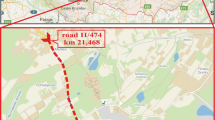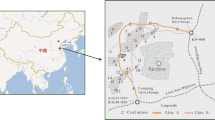Abstract
The main objective of this study is to equip engineering geology with a new, independent tool of determination of zones of potential hazard in the linear direction in order to assess the influence induced by underground coal mining on future development. Currently, geodetic polygons, maintained by mining companies, are used to monitor subsidence and their evaluation results in how mining damage is assessed. However, the problem lies in the fact that the mining company is both the authority to monitor the conditions as well as the entity that compensates mining damage on buildings. The aspect of novelty in the paper is the proposed exploitation of regular geodetic monitoring of roads as an independent tool in the determination of zones of hazard in foundation engineering. The geodetic monitoring is carried out because of road maintenance in subsidence basins. However, so far, such monitoring has not been used to identify ground deformation parameters, on the basis of which building site categories could be determined and that could help to distinguish the zones of potential hazard before any buildings are constructed in subsidence basins. In the study area, a 9-year geodetic measuring identified radically altered conditions, i.e., from more suitable building site group (category V—87 %) in the actual year of monitoring to less suitable ones (categories I and II—34 %) actual year. This methodology was found to be valid generally and may be applied in areas with subsidence basins induced by deep coal mining worldwide.








Similar content being viewed by others
References
Allgaier FK (1988) Surface subsidence over longwall panels in the western United States—final results at the Deer Creek mines, Utah. Information Circular—United States, Bureau of Mines, (9194), p 17
Beamish D, Clasen D, Greenwood PG, Peart RJ (1997) Novel regularized inversion of VLF(R) data and coincident radar sections over a probable fault affecting carboniferous sedimentary rocks in the Saar region, Germany. Geol Soc Eng Geol Spec Publ 12:45–52
Bradáč J (1996a) Účinky poddolování a ochrana objektů. Díl 1. Expert−technické nakladatelství, Ostrava
Bradáč J (1996b) Účinky poddolování a ochrana objektů: Díl 2. 1999. 178 s. Expert−technické nakladatelství, Ostrava
Can E, Mekik Ç, Kuşcu Ş, Akçin H (2013) Monitoring deformations on engineering structures in Kozlu Hard Coal Basin. Nat Hazards 65(3):2311–2330
Choi DS, Hasenfus GJ, Carter PS (1997) A case study of undermining impoundment embankments by the Longwall Mining method. Int J Rock Mech Min Sci Geomech Abstr 34(3–4):670
ČSN 730039 (1989) Design of structures in undermined areas. Standard ČSN, Basic Regulations, Prague, Czech Standards Institute, p 106 (in Czech)
Dai HY, Yi SH, Guo JT, Yan YG, Liu AJ (2013) Prediction method for surface movements and deformation induced by extra-thick steeply inclined coal seam horizontal slice mining. Meitan Xuebao/J China Coal Soc 38(8):1305–1311
Djamaluddin I, Mitani Y, Ikemi H (2012) GIS-based computational method for simulating the components of 3D dynamic ground subsidence during the process of undermining. Int J Geomech 12(1):43–53
Doležalová H, Kajzar V, Souček K, Staš L (2010) Evaluation of vertical and horizontal movements in the subsidence depression near Karviná. Acta Geodyn et Geomater 7(3):355–360
Donnelly LJ, Culshaw MG, Bell FG (2008) Longwall mining-induced fault reactivation and delayed subsidence ground movement in British coalfields. Q J Eng Geol Hydrogeol 41(3):301–314
Erginal AE, Türkeş M, Ertek TA, Baba A, Bayrakdar C (2008) Geomorphological investigation of the excavation-induced Dündar landslide, Bursa—Turkey. Geogr Ann Ser A 90A(2):109–123
Guo W, Zou Y, Hou Q (2012) Fractured zone height of longwall mining and its effects on the overburden aquifers. Int J Min Sci Technol 22(5):603–606
Jayanthu S, Gandhe A, Gupta RN (2001) Strata behaviour during undermining in multiple coal seams. J Mines Metals Fuels 49(12):449–462
Kajzar V, Doležalová H, Souček K, Staš L (2012) Gabriela locality: starting geodetic observations to detect the surface manifestations from undermining. Acta Geodyn et Geomater 9(3):401–407
Kuchin AS (2012) Analysis of maximum values of vertical and horizontal displacement of earth surface. Naukovyi Visnyk Natsionalnoho Hirnychoho Universytetu 2:36–40
Marschalko M, Třeslín L (2009) Impact of underground mining to slope deformation genesis at Doubrava Ujala. Acta Montan Slovaca 14(3):232–240
Marschalko M, Fuka M, Třeslín L (2008a) Influence of mining activity on selected landslide in the Ostrava-Karviná coalfield. Acta Montan Slovaca 13(1):58–65
Marschalko M, Fuka M, Třeslín L (2008b) Measurements by the method of precise inclinometry on locality affected by mining activity. Arch Min Sci 53(3):397–414
Marschalko M, Yilmaz I, Bednárik M, Kubečka K, Bouchal T, Závada J (2012) Subsidence map of underground mining influence for urban planning: an example from the Czech Republic. Q J Eng Geol Hydrogeol 45(2):231–241 (Cited 8 times)
Marschalko M, Yilmaz I, Křístková V, Fuka M, Kubečka K, Bouchal T (2013) An indicative method for determination of the most hazardous changes in slopes of the subsidence basins in underground coal mining area in Ostrava (Czech Republic). Environ Monit Assess 185(1):509–522
Marschalko M, Yilmaz I, Lamich D, Drusa M, Kubečková D, Peňaz T, Burkotová T, Slivka V, Bednárik M, Krčmář D, Duraj M, Sochorková A (2014) Unique documentation, analysis of origin and development of an undrained depression in a subsidence basin caused by underground coal mining (Kozinec, Czech Republic). Environ Earth Sci 72(1):11–20
Marschalko M, Yilmaz I, Kubečka K, Bouchal T, Bednárik M, Drusa M, Bendová M (2015) Utilization of ground subsidence caused by underground mining to produce a map of possible land-use areas for urban planning purposes. Arab J Geosci 8(1):579–588
McMillan AA, Browne MAE (1987) The use or abuse of thematic mining information maps. Geol Soc Eng Geol Spec Publ 4:237–245
Mikulenka V, Marschalko M (2013) Geodetic monitoring of the roads: road III/47214. VSB Technical University, Final report (in Czech, unpublished)
Onica I, Marian D (2012) Ground surface subsidence as effect of underground mining of the thick coal seams in the Jiu Valley Basin. Arch Min Sci 57(3):547–577
Pells PJ (2011) A simple method of estimating far field movements associated with longwall mining. Aust Geomech J 46(3):1–8
Unlu T, Akcin H, Yilmaz O (2013) An integrated approach for the prediction of subsidence for coal mining basins. Eng Geol 166:186–203
Van der Merwe JN (2003) Predicting coal pillar life in South Africa. J S Afr Inst Min Metall 103(5):293–301
Wagner H, Schuemann EHR (1991) Surface effects of total coal-seam extraction by underground mining methods. J S Afr Inst Min Metall 91(7):221–231
Wójcik J (2013) Mining changes on the example of the Wałbrzych Basin relief (The Sudetes, Poland). Z fur Geomorphol 57(2):187–205
Yan YG, Dai HY, Wang ZW, Jing SQ, Chen HZ (2013) Ground subsidence zone and surrounding rock failure mechanism due to steep multiple coal seam mining: a case study at Muchenyjian Datai Mine. J China Univ Min Technol 42(4):547–553
Yao CH, Yao QH (2013) The hydrogeological feature and geological hazard prevention of M coal mine in Xinjiang Fukang. Appl Mech Mater 405–408:562–565
Zhou D, Wu K, Chen R, Li L (2014) GPS/terrestrial 3D laser scanner combined monitoring technology for coal mining subsidence: a case study of a coal mining area in Hebei, China. Nat Hazards 70(2):1197–1208
Author information
Authors and Affiliations
Corresponding author
Rights and permissions
About this article
Cite this article
Lamich, D., Marschalko, M., Yilmaz, I. et al. Geodetic monitoring of roads as a tool for determination of hazard zones in areas influenced by deep coal mining. Bull Eng Geol Environ 75, 1033–1044 (2016). https://doi.org/10.1007/s10064-015-0769-y
Received:
Accepted:
Published:
Issue Date:
DOI: https://doi.org/10.1007/s10064-015-0769-y




